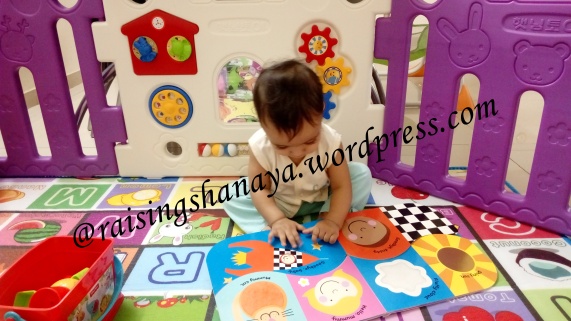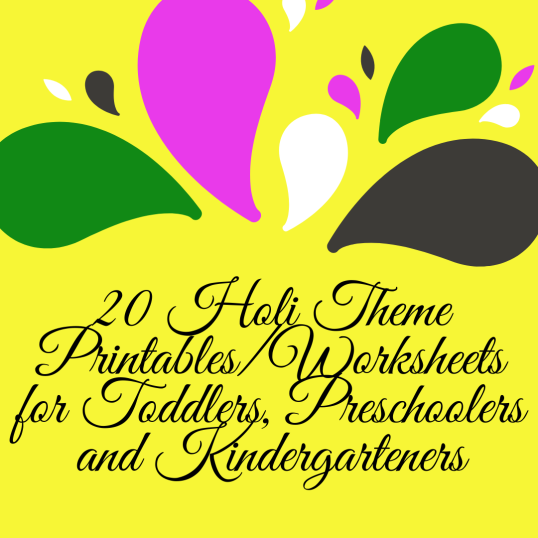Whether you’re looking for activities to build your baby’s language skills, or games to keep the toddler busy, here are some great developmental, play and learning activities for your baby from the age of 4 months to 18 months.
Why 4 months? What about 0 to 3 months? Because the first 3 months are the fourth trimester. The first 3 months are all about settling down for the new mother and baby, setting up a routine, coping with drastic lifestyle changes, sleep deprivation, endless feedings and constant diaper and dress changes!! Now that 3 months are over and you have gained some sanity and built a routine at your home, you can start thinking about aiding your baby’s development through activities.
Before enlisting the activities and games you can play with your baby 4 months onwards, I would highly recommend updating your knowledge about the milestones your infant has achieved or is going to achieve. Knowing the milestones helps you and the baby to enjoy activities without the stress of expectation and needless worry on your part. Based on these milestones and to encourage your infant (upto 12 months age) or toddler (12 months +) for the next milestones, you can do these activities and play these games:-

#1 Touch, Sing and Tummy time – Touch your child frequently, blow raspberries on her tummy, give hugs and cuddles, give massage, sing to your child, dance in front of your child, sing rhymes with voice modulations and funny faces and listen to good music with your baby. Give plenty of tummy time in the afternoons. It’s a precursor for crawling and moving around and also for strengthening their neck muscles.
#2 Read books to your child – Read..read..read to your kids. Read everyday..even if it is just for 15 minutes. The best books to start interacting for infants are black and white contrast books, cloth books especially crinkly ones and touch and feel books. Then you can move on to one or two words per page books, board books with baby faces (they love looking at other babies!!), mirrors surprises, pop up books (careful they may tear the pop up) , lift the flap, touch and feel books, sound books, books with big illustrations and text, books with rhyming text which parent reads with voice modulations with actions. Give your infant tummy time with touch and feel books. As you read to your toddler, encourage them to point out familiar objects in the illustrations. After your child is 12 months old, you can start reading first words books, object and names type of books, picture books where you can narrate the story and also read the story later on as the child’s vocabulary and comprehension gets stronger. Once you start reading you will understand your child’s interest and taste and you can more buy or borrow books in that category.

#3 Set up a play-area – It need not be a room dedicated to the child..it need not be lavish…just a corner of your living room will do! Just set up a soft rug or play-mat with age appropriate toys, sensory materials like sensory balls, wooden toys, soft toys and board books lying around and if possible a wall mirror. When your child starts crawling you can use play pen to restrict movement when you go to the bathroom or you are doing any chore. Such a play area is constantly evolving as the child grows and we still have a dedicated play area after 4 years!

#4 Rattles – One of the best toys to buy for your baby is a set of rattles. Keep rattle above baby’s chest, on sides and encourage your baby to reach for them. While baby is sitting, place toys out of his reach so he has to shift his weight and move to get the toy. This helps the baby to develop motor skills and hand eye coordination. I recommend the Mee Mee Baby Rattle Gift Set (7 Piece)
#5 Talk, Talk, Talk..Act, Act, Act – Whenever your baby makes babbling sounds, respond to him/her as if in conversation. Repeat sounds they make and add new words. This helps the baby to develop communication skills and even if they can’t talk right now the words are getting stored in their memory and increasing their vocabulary and recognition. Baby will learn the give and take of communication and may begin to babble sounds from words they’ve heard you say. Talk about every action you are doing, describe every object around him/her..its colour, its shape its texture, go on nature walk and talk about the surroundings, talk about events of the day, say the names of his body parts and then ask him to point to his nose, eyes, ears, etc. Ask him to point to your nose, eyes, and ears etc. Use puppet toys to talk with your child, tell stories using finger puppets. Use a play telephone to practice saying hello or goodbye. Practice new gestures with baby like blowing kisses, clapping hands, or giving a high five. Practice waving bye-bye when a guest leaves your home.
#6 Sensory Bags – Create a sensory bag for your child by combining textured items in a sealable plastic bags. You can create a sensory bag out of pretty much anything, Just search on Pinterest. You can use rice, playdough, colorless liquid soap filled with colorful small beads, water beads etc etc. Make sure you seal it with duct tape and also tape the bag to ground on four sides. Place your child down on his tummy, either over a bolster or on the floor directly. Put the sensory bag down in front of him, and let him explore away. Click on this for sensory bags ideas. You can also make sensory bottles.
#7 Object Permanence – Babies have separation anxiety because they think when Mom has gone she has gone forever. When something is gone from sight, it no longer exists for the child. Slowly they learn about object permeance i.e. the ability to understand that objects exist even when not seen and it is one of an infant’s primary developmental accomplishments. To help achieve this understanding, either you can buy the Montessori toy “Object Permeance Box” or you can make it yourself.
#8 Peek-a-Boo – Play peek-a-boo right from 4 months age..trust me it is going to be favorite game for a long time!! Cover your face with your hands. Surprise baby when you appear again. When you reappear, say her name and give her a wide smile. As the child grows older, simply hide behind a large piece of furniture and come out and say “peek-a-boo” or whatever it is called in your language. This game helps with object permeance development too.
#9 Stacking Ring and Shape sorters – Another of the top 10 toys you should invest in for your child are stacking and shape sorting toys. It is only after 20 months or so the child can fit the shapes and rings correctly so do not expect your infant to do the same..but still they enjoy these bright colorful toys so much!! The toys can be used in different ways till at least 4 years of age! My recommendations are Little’s Junior Ring (Multicolour), Funskool Giggles Stacking Drums, Playskool Form Fitter and Fisher-Price Brilliant Basics Baby’s First Blocks.

#9 Hand Eye Coordination Activities – Hand-eye coordination is the ability to use our muscles and our vision in sync…our vision controls, guides, and directs the muscles of the hand to proceed in particular direction and grasp the target object. Your infant is still developing this very important skill which is going to be useful for eating, playing, combing hair, writing etc and there are so many age appropriate activities you can do to encourage your child. Examples of these activities (you can find a plethora of them on Pinterest) – Emptying things from a jar/basket and putting them back, Dropping pom poms/ posting items into a container/box either by hand or a scoop, Sorting activities, Peg and cup, Hanging ribbons, putting colorful ping pong balls in a container or box, playing ball..starting from rolling the ball towards the baby to playing throw and catch with your toddler, suspend a ball or balloon from a safe place and ask your toddler to try and hit it with a plastic bat, introduce wooden peg puzzles for your 12 months+ toddler…start with chunky ones and then proceed to thinner pegs, blow bubbles for your toddler..encourage her to touch and pop them.

#10 Sound Effect Activities – Babies love noisy toys and sound books. Baby is starting to learn cause and effect and they have a natural instinct to experiment to learn the effect of their actions. The first instinct of experimentation by a baby is to shake, drop, or bang toys together. You can give baby household items like pots, pans, spoons, etc. Bang a wooden spoon on different objects and show how different sounds are produced. Crumple paper bags, newspapers, crinkly papers and see the interest of your baby!!
#11 Sensory Experiences – Once your baby has started sitting in highchair then involve him/her while you are working in kitchen..try making your time in the kitchen a learning experience. Let baby smell the foods you are cooking and talk through what you are doing. When you take the baby out on a nature walk, show different colours, let him touch various but safe leaves, smell different flowers, crunch on dead leaves, show animals, birds, insects etc.
#12 Colouring – After around 10 months of age, you can introduce coloring material. Since the baby would still have the exploratory instinct to put things in her mouth, make edible finger paints at home (for example curd/yoghurt mixed with beetroot juice for red, spinach juice for green, turmeric for yellow) and let her explore painting on paper taped on floor. Introduce ball crayons or palm grip crayons under strict supervision and make some scribble marks on the paper while your child is watching, and encourage her to try as well. Praise any artistic creations she makes. If you want your child to not scribble on walls or furniture, start telling positive instruction like “painting and coloring is only done on paper”repeatedly and persistently…the child will absorb the instruction and learn it.
So these are the top 12 Developmental, Play and Learning Activities for 4 months to 18 months that you can try with your infant/toddler. Hope your baby and you have the most enjoyable time doing these and make some wonderful memories together!! Do let me know in comments!!
It is on 9th March. Shanaya loves Holi as she gets to apply color on our faces
















